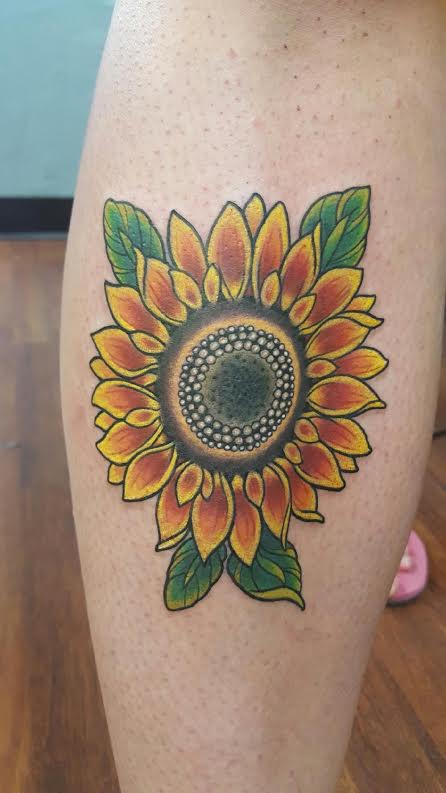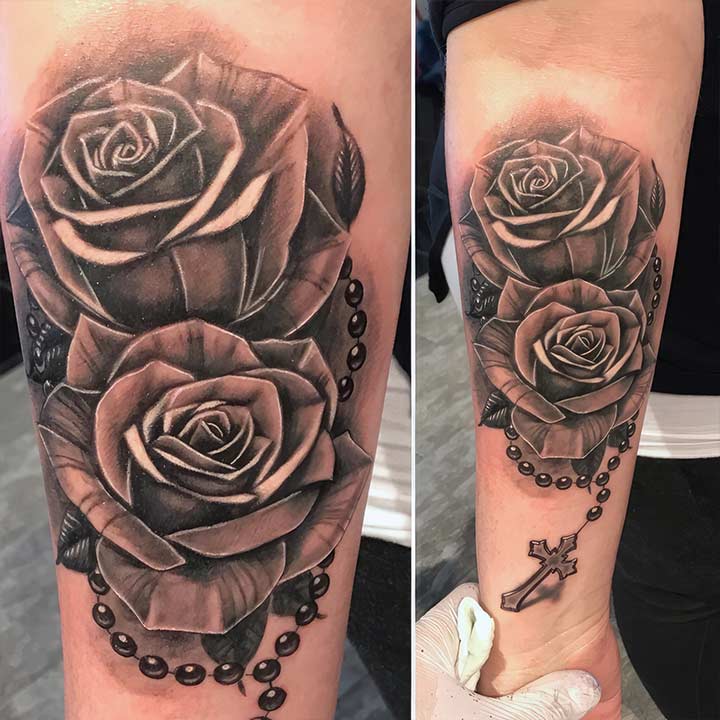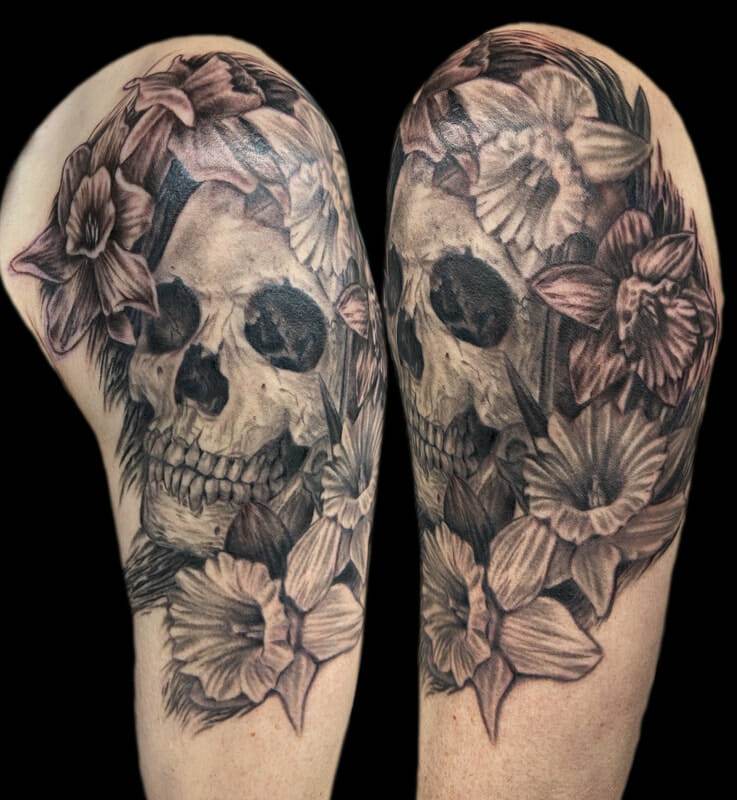Floral tattoos have become increasingly popular in recent years, with more and more people choosing to adorn their bodies with the beauty of nature. These tattoos are not only aesthetically pleasing, but they also hold deep symbolism and meaning. From ancient cultures to modern times, floral tattoos have been a way for individuals to express themselves and connect with the natural world. In this article, we will explore the history, types, symbolism, placement, styles, inspiration, and aftercare of floral tattoos. Whether you are considering getting a floral tattoo or simply appreciate their beauty, this article will provide you with a comprehensive guide to everything you need to know about floral tattoos.
History of Floral Tattoos: From Ancient Cultures to Modern Times
The origins of floral tattoos can be traced back to ancient cultures, where they held significant meaning and symbolism. In ancient Egypt, for example, lotus flowers were often depicted in artwork and were associated with rebirth and the afterlife. In Japan, cherry blossoms symbolize the transient nature of life and are often used in traditional tattoo designs. In Native American culture, sunflowers represent strength and fertility.
Throughout history, floral tattoos have evolved and adapted to different time periods and cultures. In the 18th and 19th centuries, floral tattoos became popular among sailors as a way to commemorate their travels and experiences. These tattoos often featured roses, which symbolized love and beauty. In the 1960s and 1970s, floral tattoos became associated with the counterculture movement and were often seen as a form of self-expression and rebellion.
Types of Floral Tattoos: Roses, Lilies, Sunflowers, and More
There are countless types of flowers that can be used in floral tattoo designs, each with its own unique characteristics and meanings. Some of the most popular choices include roses, lilies, sunflowers, cherry blossoms, and lotus flowers.
Roses are perhaps the most iconic and versatile flower used in tattoo designs. They can symbolize love, beauty, and passion, but their meaning can also vary depending on the color of the rose. Red roses are often associated with romantic love, while yellow roses symbolize friendship and joy.
Lilies are another popular choice for floral tattoos. They are often associated with purity, innocence, and spirituality. In Christian symbolism, lilies are often associated with the Virgin Mary and are seen as a symbol of her purity.
Sunflowers are a vibrant and cheerful choice for a floral tattoo. They symbolize happiness, positivity, and loyalty. Sunflowers are often associated with the sun and its life-giving properties.
Cherry blossoms are a popular choice in Japanese tattoo designs. They represent the transient nature of life and are often associated with beauty and the impermanence of things.
Lotus flowers are deeply symbolic in many cultures, particularly in Buddhism. They represent purity, enlightenment, and spiritual growth. Lotus flowers are often depicted as blooming from muddy waters, symbolizing the ability to rise above challenges and obstacles.
The Symbolism of Floral Tattoos: What Do They Represent?
Floral tattoos hold deep symbolism and meaning, which can vary depending on the type of flower, color, and placement. In general, floral tattoos are often associated with beauty, femininity, and nature. However, each flower has its own unique symbolism.
As mentioned earlier, roses symbolize love and beauty. They can also represent passion, desire, and sensuality. The color of the rose can further enhance its meaning. For example, a red rose represents romantic love, while a black rose can symbolize death or farewell.
Lilies are often associated with purity and innocence. They can also represent fertility and motherhood. In some cultures, lilies are seen as a symbol of death and are often used in funeral arrangements.
Sunflowers symbolize happiness, positivity, and loyalty. They are often associated with the sun and its life-giving properties. Sunflowers can also represent growth and resilience.
Cherry blossoms are often associated with beauty and the transient nature of life. They symbolize the fleeting nature of beauty and the impermanence of things. Cherry blossoms are often used in tattoo designs to represent the beauty and fragility of life.
Lotus flowers are deeply symbolic in many cultures, particularly in Buddhism. They represent purity, enlightenment, and spiritual growth. Lotus flowers are often depicted as blooming from muddy waters, symbolizing the ability to rise above challenges and obstacles.
Placement of Floral Tattoos: Where to Get Inked

The placement of a floral tattoo can greatly impact its meaning and symbolism. There are several popular locations for floral tattoos, each with its own unique significance.
The wrist is a popular choice for floral tattoos, as it allows for easy visibility and can be easily covered if desired. Floral tattoos on the wrist can symbolize femininity, beauty, and grace.
The ankle is another popular location for floral tattoos. This placement can be particularly meaningful for those who enjoy being connected to the earth and nature. Ankle tattoos can also symbolize freedom and independence.
The shoulder is a versatile location for floral tattoos, as it provides a larger canvas for intricate designs. Shoulder tattoos can symbolize strength, resilience, and protection.
The back is another popular location for floral tattoos, as it allows for larger and more elaborate designs. Back tattoos can symbolize personal growth, transformation, and inner strength.
Ultimately, the placement of a floral tattoo is a personal choice and should be based on your own preferences and desired symbolism.
Color vs. Black and Gray: Choosing the Right Style for Your Floral Tattoo
When it comes to floral tattoos, there are two main styles to consider: color and black and gray. Each style has its own unique characteristics and can greatly impact the overall look and feel of the tattoo.
Colorful floral tattoos are vibrant and eye-catching. They can bring the design to life and make it appear more realistic. Colorful tattoos are often associated with joy, energy, and positivity. However, it’s important to keep in mind that color tattoos may require more frequent touch-ups to maintain their vibrancy.
On the other hand, black and gray floral tattoos have a more subtle and timeless appeal. They can give the design a more classic and elegant look. Black and gray tattoos are often associated with depth, mystery, and sophistication. They also tend to age better than color tattoos, as they are less prone to fading over time.
When choosing between color and black and gray for your floral tattoo, it’s important to consider your personal preferences, the overall design of the tattoo, and how you want it to look in the long run. Consulting with a tattoo artist can help you make an informed decision based on your individual needs and desires.
Finding Inspiration: Ideas for Your Floral Tattoo Design
If you’re considering getting a floral tattoo but are unsure of what design to choose, there are several ways to find inspiration.
One of the best ways to find inspiration for your floral tattoo design is by browsing online galleries and social media platforms dedicated to tattoos. Websites such as Pinterest and Instagram are great resources for finding a wide range of floral tattoo designs. You can save images that resonate with you and use them as a starting point for your own design.
Another way to find inspiration is by consulting with a tattoo artist. Tattoo artists are skilled in creating custom designs based on your ideas and preferences. They can provide guidance on what will work best for your body shape, skin tone, and desired placement. Tattoo artists often have portfolios of their previous work that you can browse through to get an idea of their style and capabilities.
Personalizing your floral tattoo design is another way to make it unique and meaningful. Consider incorporating elements that are significant to you, such as initials, birthstones, or symbols that hold personal meaning. Adding these personal touches can make your floral tattoo even more special and meaningful.
Aftercare Tips: How to Properly Care for Your New Floral Tattoo
Proper aftercare is essential for ensuring the healing and longevity of your new floral tattoo. Here are some tips on how to care for your tattoo:
Keep it clean: Gently wash your tattoo with mild soap and warm water, using your hands or a clean, soft cloth. Avoid scrubbing or using harsh products, as this can irritate the skin and slow down the healing process.
Moisturize: Apply a thin layer of fragrance-free, non-comedogenic moisturizer to your tattoo to keep it hydrated. Avoid petroleum-based products, as they can clog pores and prevent proper healing.
Avoid direct sunlight: Protect your tattoo from direct sunlight, as UV rays can fade the colors and damage the skin. If you need to be in the sun, apply a broad-spectrum sunscreen with a high SPF to your tattoo.
Avoid swimming: Avoid swimming in pools, hot tubs, or natural bodies of water until your tattoo is fully healed. These environments can introduce bacteria and increase the risk of infection.
Avoid picking or scratching: It’s important to resist the urge to pick or scratch at your tattoo, as this can cause scarring and slow down the healing process. If your tattoo becomes itchy, gently pat it with clean hands instead of scratching.
Follow any additional instructions provided by your tattoo artist. They may recommend specific aftercare products or techniques based on their expertise and the specific needs of your tattoo.
Removing or Covering Up Floral Tattoos: What Are Your Options?
While floral tattoos are often chosen for their beauty and symbolism, there may come a time when you want to remove or cover up a tattoo. There are several options available for removing or covering up floral tattoos:
Laser removal: Laser tattoo removal is a popular method for completely removing unwanted tattoos. This procedure uses laser technology to break down the ink particles in the skin, allowing them to be naturally eliminated by the body’s immune system. Laser removal can be effective, but it may require multiple sessions and can be expensive.
Cover-up tattoos: Another option for hiding or altering a floral tattoo is to get a cover-up tattoo. A skilled tattoo artist can design a new tattoo that incorporates and covers the existing design. This can be a great option if you want to completely change the look of your tattoo or if you want to add more elements to an existing design.
Tattoo removal creams: There are various tattoo removal creams available on the market that claim to fade or remove tattoos. However, the effectiveness of these creams is often debated, and they may not be as effective as other methods such as laser removal.
Consult with a tattoo removal specialist or a tattoo artist who specializes in cover-up tattoos to discuss your options and determine the best course of action based on your specific needs and preferences.

The Timeless Appeal of Floral Tattoos
Floral tattoos have a timeless appeal that transcends cultures and time periods. They are not only aesthetically pleasing but also hold deep symbolism and meaning. From ancient cultures to modern times, floral tattoos have been a way for individuals to express themselves and connect with the natural world.
Whether you choose a rose, lily, sunflower, cherry blossom, or lotus flower, each type of floral tattoo carries its own unique symbolism and meaning. The placement and style of the tattoo can further enhance its significance.
When getting a floral tattoo, it’s important to choose a skilled tattoo artist who specializes in floral designs and follows proper hygiene practices. Aftercare is also crucial for ensuring the healing and longevity of your new tattoo.
Whether you’re considering getting a floral tattoo or simply appreciate their beauty, floral tattoos are a timeless form of self-expression that can bring joy and meaning to your life. Approach the process with care and thoughtfulness, and you’ll have a beautiful piece of art that will last a lifetime.



